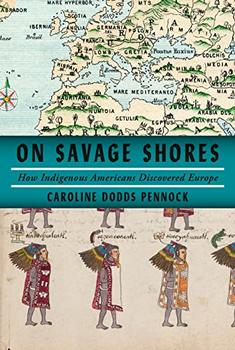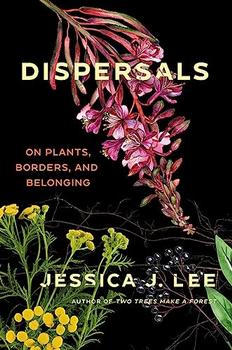Summary | Excerpt | Reviews | Beyond the Book | Readalikes | Genres & Themes | Author Bio

 Book Reviewed by:
Book Reviewed by:
Peggy Kurkowski
Buy This Book
Chapter 1
Slavery
From the earliest encounters, Native peoples were seen by Europeans as a commodity to be exploited. On 11 October 1492, Columbus's crew 'discovered America', or more accurately, they first sighted the Taíno island of Guanahaní, which they 'took possession of ... in the names of the King and Queen', undeterred by the fact the island was quite obviously 'possessed' already. That day, Columbus concluded his diary: '[The people] ought to make good slaves for they are of quick intelligence since I notice that they are quick to repeat what is said to them, and I believe that they could very easily become Christians, for it seemed to me that they had no religion of their own. God willing, when I come to leave I will bring six of them to Your Highnesses so that they may learn to speak. And take them he did.
Exactly a month after Columbus's crew first spied land, five young Indigenous men who had paddled a canoe out to his flagship, the Santa María, found themselves 'detained'. Seven women and three children were also abducted from a nearby house and carried on board. According to Columbus's letters, these people—not even the first to be stolen from the islands—were taken 'by force' in order to 'learn our language, so that we would know what there is in this land and so that on their return they could act as interpreters'. Based on his experience of African enslavement, Columbus was convinced that 'the men would behave themselves better in Spain with their own women than without them' because 'if they have their women, they will be more willing to provide the cooperation expected of them'. Fascinatingly, Columbus also seemed to think that it was the women who would 'do much to teach our men the language', disturbingly foreshadowing the later trafficking of Native women, ostensibly as intermediaries, but often also into sexual slavery. The following night, a man of about forty-five years old rowed out to the ship and begged to be allowed to accompany his wife, son and two daughters, who were among the prisoners. The man was allowed aboard, becoming perhaps the first Indigenous American to 'voluntarily' travel to Europe, albeit under extreme duress. Tragically, we do not know whether he or his family ever made the trip, as only six or seven of the islanders survived to be presented to the Catholic monarchs, Ferdinand and Isabella, in April 1493.
These Indigenous people may not have intended, or wanted, to be explorers, but they were still the first of their people to set foot in the 'new world' of Europe. These were Lucayan Taíno people, their name deriving from the Arawak words 'Lukkunu Kaíri' (good island people). They were the main inhabitants of the larger islands, and their lifestyle seemed in some ways to conform to European expectations of 'primitive' people: they frequently went naked and lived in communal houses built of wood, straw and palms. But they had sophisticated polities and kinship networks which the Spanish (and, for many years, scholars) failed to recognise. Despite the decorous protocol and complex etiquette which typified his early exchanges with Taíno chiefs, Columbus nonetheless behaved as if their people were objects, grabbing Native men, women and children as he journeyed along what is now the Bahamian archipelago. In November 1492, the Admiral kidnapped around two dozen people from Cuba, and shipped them to Spain as 'curiosities' and potential translators. The careless objectification of the Taíno is typical of European attitudes to Indigenous peoples; they were valued and treated according to what would make them of most use. But the Spaniards were also aware that these were humans, and potential Christians, a fact which proved of considerable importance in the years to come.
It must have been overwhelming for the Taíno travellers. Ripped away from their homes, they spent several months trapped on a strange ship, facing the terrors of the ocean, and watching their companions die one by one. No strangers to waterborne commerce and transport, these island men would have been well acquainted with travel in large canoes, and with the vicissitudes of being on the water. But a long ocean crossing on an enclosed vessel was an entirely different proposition. We have few records of the minutiae of life at sea in this period, but the Spanish judge Eugenio de Salazar left a fabulously evocative record of his transatlantic passage when he was posted to Santo Domingo in 1573. Although written close to a century after the Taínos' voyage, Salazar's account gives a rare insight into life aboard an ageing caravel similar to the smaller ships used by Columbus. The crowded conditions and cramped quarters he describes are almost unimaginable. As a senior official, he was granted the 'great privilege' of 'a tiny cabin, about two feet by three', in which he was crammed with his wife and daughter while suffering relentless seasickness in almost complete darkness. The less fortunate were crowded together in 'dwellings [that] are so closed in, dark, and evil-smelling that they seem to be more like burial vaults or charnelhouses [where skeletons were stored]'. Complaining of the stinking water, the corrupt and draconian crew, 'flights of cockroaches', 'rats so fierce that when they are cornered they turn on the hunters like wild boars', he abhorred the communal life, people of all ranks crowded cheek by jowl, eating, cooking, belching, vomiting and emptying their bowels without restraint. 'At sea there is no hope that the road, or the host, or the lodging will improve; everything grows steadily worse; the ship labors more and more and the food gets scantier and nastier every day', he wrote. It is hard not to reflect on the experiences of enslaved Black and Native people who were crammed into the holds of the European ships which ploughed the same route. If the accommodations of free people were like 'the caves of Hell', 'dark by day and pitch-black by night', what horrors were inflicted on those forced to endure sickness and excrement without relief?
Excerpted from On Savage Shores by Caroline Dodds Pennock. Copyright © 2023 by Caroline Dodds Pennock. All rights reserved. No part of this excerpt may be reproduced or reprinted without permission in writing from the publisher.




If passion drives you, let reason hold the reins
Click Here to find out who said this, as well as discovering other famous literary quotes!
Your guide toexceptional books
BookBrowse seeks out and recommends the best in contemporary fiction and nonfiction—books that not only engage and entertain but also deepen our understanding of ourselves and the world around us.